Transcription of AN89 - A Thermoelectric Cooler Temperature …
1 Application Note 89. April 2001. A Thermoelectric Cooler Temperature controller for Fiber Optic Lasers Climatic Pampering for Temperamental Lasers Jim Williams INTRODUCTION. Temperature controller Requirements Continued demands for increased bandwidth have re- sulted in deployment of fiber optic-based networks. The The Temperature controller must meet some unusual fiber optic lines, driven by solid state lasers, are capable of requirements. Most notably, because of ambient tempera- very high information density. Highly packed data schemes ture variation and laser operation uncertainties, the con- such as DWDM (dense wavelength division multiplexing) troller must be capable of either sourcing or removing heat utilize multiple lasers driving a fiber to obtain large multi- to maintain control.
2 Peltier-based Thermoelectric coolers channel data streams. The narrow channel spacing relies (TEC) permit this but the controller must be truly bidirec- on laser wavelength being controlled within (na- tional. Its heat flow control must not have dead zone or nometer). Lasers are capable of this but Temperature untoward dynamics in the hot-to-cold transition region. variation influences operation. Figure 1 shows that laser Additionally, the Temperature controller must be a preci- output peaks sharply vs wavelength, implying that laser sion device capable of maintaining control well inside wavelength must be controlled well within to main- C over time and Temperature variations. tain performance. Figure 2 plots typical laser wavelength Laser based systems packaging is compact, necessitating vs Temperature .
3 The C slope means that although small solution size with efficient operation to avoid exces- Temperature facilitates tuning laser wavelength, it must sive heat dissipation. Finally, the controller must operate not vary once the laser has been peaked. Typically, tem- from a single, low voltage source and its (presumably perature control of C is required to maintain laser switched mode) operation must not corrupt the supply operation well within with noise. 1555. (SOURCE: FUJITSU FLD5F10NP DATA SHEET) (SOURCE: FUJITSU FLD5F10NP DATA SHEET). RELATIVE INTENSITY (10dB/DIV). 1554. WAVELENGTH (nm). 1553. 1552 SLOPE = C. 1551. 1550. WAVELENGTH 10 20 30 40. (1nm/DIV, RESOLUTION = )AN89 F01 LASER Temperature ( C). AN89 F02. Figure 1. Laser Intensity Peak Approaches Figure 2. Laser Wavelength Varies C.
4 40dB within a 1nm Window Typical Application Requires Wavelength Stability within , Mandating Temperature Control , LTC and LT are registered trademarks of Linear Technology Corporation. AN89-1. Application Note 89. Temperature controller Details switching related harmonics by slowing down the power stages' transition times. This greatly reduces high fre- Figure 3, a schematic of the Thermoelectric Cooler (TEC). quency harmonic content, preventing excessive switching Temperature controller , includes three basic sections. The related noise from corrupting the power supply or the DAC and the thermistor form a bridge, the output of which The switched mode power output stage, an H- is amplified by A1. The LTC1923 controller is a pulse width bridge type, permits efficient bidirectional drive to the modulator which provides appropriately modulated and TEC, allowing either heating or cooling of the laser.
5 The phased drive to the power output stage. The laser is an thermistor, TEC and laser, packaged at manufacture within electrically delicate and very expensive load. As such, the the laser module, are tightly thermally coupled. controller provides a variety of monitoring, limiting and overload protection capabilities. These include soft-start The DAC permits adjusting Temperature setpoint to any and overcurrent protection, TEC voltage and current sense individual laser's optimum operating point, normally speci- and out-of-bounds Temperature sensing. Aberrant op- fied for each laser. controller gain and bandwidth adjust- eration results in circuit shutdown, preventing laser mod- ments optimize thermal loop response for best Temperature ule damage. Two other features promote system level stability.
6 Compatibility. A phase-locked loop based oscillator per- mits reliable clock synchronization of multiple LTC1923s Thermal Loop Considerations in multilaser systems. Finally, the switched mode power The key to high performance Temperature control is match- delivery to the TEC is efficient but special considerations ing the controller 's gain bandwidth to the thermal feed- are required to ensure that switching related noise is not back path. Theoretically, it is a simple matter to do this introduced ( reflected ) into the host power supply. The using conventional servo-feedback techniques. Practi- LTC1923 includes edge slew limiting which minimizes F. 10k * = SUGGESTED VALUES SEE TEXT. PLLLPF RT. LTC1923 330pF L1, L2: SUMIDA CDRH8D28-100NC, 10 H. TO AT LTC1923 82k Q1, Q2: Si9801DY N-P DUAL.
7 10k RSLEW CT. TEC-RTHERMISTOR ARE PART OF LASER MODULE. REFIN. + 5V SDSYNC VREF RTHERMISTOR IS TYPICALLY 10k AT 25 C. CLK 10k A1 1 F. LTC2053 EAIN +. DIN LTC1658 9k F. FILM PDRVB. CS/LD EAOUT NDRVB. LOOP GAIN F*. F 1k* TANTALUM + 10M VDD 5V. FILM. EAIN 1 F. 5V. 100k LOOP AGND PGND +. BANDWIDTH 22 F. SS PDRVA TEC. 1 F NDRVA L1 L2. CERAMIC Q1 Q2. ILIM. 10k CS +.. F CS 22 F 22 F. TO VSET. FAULT. VTHERM ITEC. H/C TEC + F. RTHERMISTOR THERMAL FEEDBACK. VTEC TEC . AN89 F03. Figure 3. Detailed Schematic of TEC Temperature controller Includes A1 Thermistor Bridge Amplifier, LTC1923 Switched Mode controller and Power Output H-Bridge. DAC Establishes Temperature Setpoint. Gain Adjust and Compensation Capacitor Optimize Loop Gain Bandwidth. Various LTC1923 Outputs Permit Monitoring TEC Operating Conditions Note 1: This technique derives from earlier efforts.
8 See Reference 1 for detailed discussion and related topics. AN89-2. Application Note 89. cally, the long time constants and uncertain delays inher- Temperature Control Loop Optimization ent in thermal systems present a challenge. The unfortu- Temperature control loop optimization begins with ther- nate relationship between servo systems and oscillators is mal characterization of the laser module. The previous very apparent in thermal control systems. section emphasized the importance of the ratio between The thermal control loop can be very simply modeled as a the TEC-sensor and insulation time constants. Determina- network of resistors and capacitors. The resistors are tion of this information places realistic bounds on achiev- equivalent to the thermal resistance and the capacitors to able controller gain bandwidth.
9 Figure 5 shows results thermal capacity. In Figure 4 the TEC, TEC-sensor inter- when a typical laser module is subjected to a 40 C step face and sensor all have RC factors that contribute to a change in ambient Temperature . The laser module's inter- lumped delay in the system's ability to respond. To prevent nal Temperature , monitored by its thermistor, is plotted vs oscillation, gain bandwidth must be limited to account for time with the TEC unpowered. An ambient-to-sensor lag this delay. Since high gain bandwidth is desirable for good measured in minutes shows a classic first order response. control, the delays should be minimized. This is presum- The TEC-sensor lumped delay is characterized by operat- ably addressed by the laser module's purveyor at manu- ing the laser module in Figure 3's circuit with gain set at facture.
10 Maximum and no compensation capacitor installed. Fig- The model also includes insulation between the controlled ure 6 shows large-signal oscillation due to thermal lag environment and the uncontrolled ambient. The function dominating the loop. A great deal of valuable information of insulation is to keep the loss rate down so the tempera- is contained in this The frequency, primarily ture control device can keep up with the losses. For any determined by TEC-sensor lag, implies limits on how given system, the higher the ratio between the TEC-sensor much loop bandwidth is achievable. The high ratio of this time constants and the insulation time constants, the frequency to the laser module's thermal time constant better the performance of the control (Figure 5) means a simple, dominant pole loop compen- 70.

















